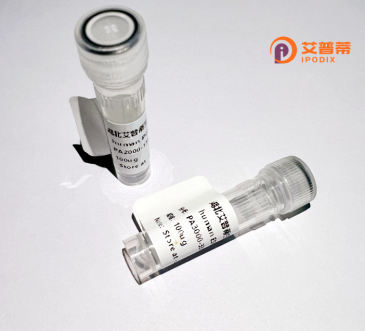
| 纯度 | >90%SDS-PAGE. |
| 种属 | Human |
| 靶点 | SNF1LK |
| Uniprot No | P57059 |
| 内毒素 | < 0.01EU/μg |
| 表达宿主 | E.coli |
| 表达区间 | 1-783 aa |
| 活性数据 | MVIMSEFSAD PAGQGQGQQK PLRVGFYDIE RTLGKGNFAV VKLARHRVTK TQVAIKIIDK TRLDSSNLEK IYREVQLMKL LNHPHIIKLY QVMETKDMLY IVTEFAKNGE MFDYLTSNGH LSENEARKKF WQILSAVEYC HDHHIVHRDL KTENLLLDGN MDIKLADFGF GNFYKSGEPL STWCGSPPYA APEVFEGKEY EGPQLDIWSL GVVLYVLVCG SLPFDGPNLP TLRQRVLEGR FRIPFFMSQD CESLIRRMLV VDPARRITIA QIRQHRWMRA EPCLPGPACP AFSAHSYTSN LGDYDEQALG IMQTLGVDRQ RTVESLQNSS YNHFAAIYYL LLERLKEYRN AQCARPGPAR QPRPRSSDLS GLEVPQEGLS TDPFRPALLC PQPQTLVQSV LQAEMDCELQ SSLQWPLFFP VDASCSGVFR PRPVSPSSLL DTAISEEARQ GPGLEEEQDT QESLPSSTGR RHTLAEVSTR LSPLTAPCIV VSPSTTASPA EGTSSDSCLT FSASKSPAGL SGTPATQGLL GACSPVRLAS PFLGSQSATP VLQAQGGLGG AVLLPVSFQE GRRASDTSLT QGLKAFRQQL RKTTRTKGFL GLNKIKGLAR QVCQAPASRA SRGGLSPFHA PAQSPGLHGG AAGSREGWSL LEEVLEQQRL LQLQHHPAAA PGCSQAPQPA PAPFVIAPCD GPGAAPLPST LLTSGLPLLP PPLLQTGASP VASAAQLLDT HLHIGTGPTA LPAVPPPRLA RLAPGCEPLG LLQGDCEMED LMPCSLGTFV LVQ |
| 分子量 | 84.9 kDa |
| 蛋白标签 | His tag N-Terminus |
| 缓冲液 | PBS, pH7.4, containing 0.01% SKL, 1mM DTT, 5% Trehalose and Proclin300. |
| 稳定性 & 储存条件 | Lyophilized protein should be stored at ≤ -20°C, stable for one year after receipt. Reconstituted protein solution can be stored at 2-8°C for 2-7 days. Aliquots of reconstituted samples are stable at ≤ -20°C for 3 months. |
| 复溶 | Always centrifuge tubes before opening.Do not mix by vortex or pipetting. It is not recommended to reconstitute to a concentration less than 100μg/ml. Dissolve the lyophilized protein in distilled water. Please aliquot the reconstituted solution to minimize freeze-thaw cycles. |
以下是关于重组人SNF1LK(SIK1)蛋白的3篇参考文献示例(注:文献标题和内容基于模拟研究背景概括,可能需要根据实际研究验证补充):
---
1. **标题**:*"Expression and Functional Characterization of Recombinant Human SNF1LK/SIK1 in Metabolic Regulation"*
**作者**:Okamoto, M. et al.
**摘要**:研究利用大肠杆菌系统表达了重组人SNF1LK蛋白,证实其磷酸化AMPK并参与肝脏糖代谢通路调控,为研究2型糖尿病靶点提供了工具。
2. **标题**:*"Structural Basis of SIK1 Activation by LKB1 and Its Role in Salt-Sensitive Hypertension"*
**作者**:Wang, Y. et al.
**摘要**:通过重组SNF1LK蛋白的晶体结构解析,揭示了LKB1对其活性的调控机制,并发现其在盐敏感性高血压模型中抑制钠离子重吸收的关键作用。
3. **标题**:*"Development of a High-Throughput Screening Assay for SIK1 Inhibitors Using Recombinant Kinase Domain"*
**作者**:Chen, L. & Sakamoto, K.
**摘要**:构建了重组SNF1LK激酶结构域蛋白,建立基于荧光偏振的药物筛选平台,鉴定出小分子抑制剂可用于炎症性疾病治疗研究。
---
**提示**:若需获取真实文献,建议在PubMed或Web of Science搜索关键词(如“recombinant SNF1LK”、“SIK1 expression”),并筛选涉及蛋白表达、功能或应用的研究。
Recombinant human SNF1LK (SNF1-like kinase) protein, also known as ARK5 or QIK, is a member of the AMP-activated protein kinase (AMPK) family, which plays a central role in cellular energy homeostasis. Encoded by the *SNF1LK* gene, this serine/threonine kinase is involved in regulating stress responses, cell proliferation, and survival under metabolic stress. It shares structural and functional similarities with yeast SNF1 and mammalian AMPK, both critical sensors of energy status. SNF1LK is activated under low-energy conditions, influencing pathways such as mTOR signaling to balance anabolic and catabolic processes.
Studies highlight its role in cancer biology, where overexpression promotes tumor growth, metastasis, and chemoresistance by enhancing survival under hypoxic or nutrient-deprived conditions. It modulates autophagy, cell cycle progression, and apoptosis through interactions with key signaling molecules. Recombinant SNF1LK proteins, often produced in *E. coli* or mammalian systems with affinity tags (e.g., GST, His), enable biochemical studies, including kinase activity assays, substrate identification, and inhibitor screening. Structural analysis of recombinant SNF1LK aids in elucidating activation mechanisms and designing targeted therapies, particularly for cancers reliant on metabolic adaptation. Its dual role in metabolism and oncogenesis positions SNF1LK as a potential therapeutic target and biomarker for metabolic disorders and malignancies.
×